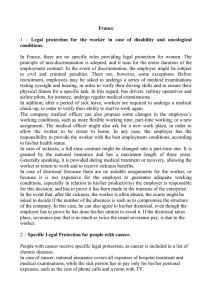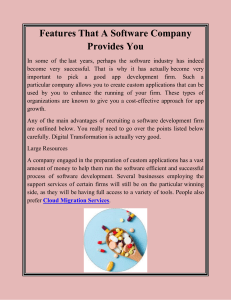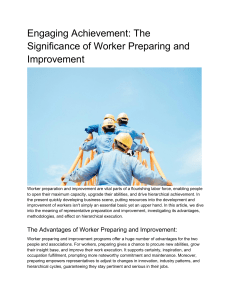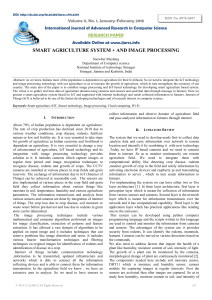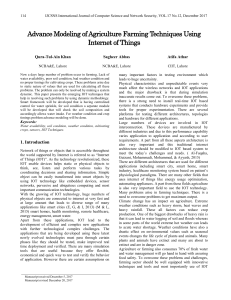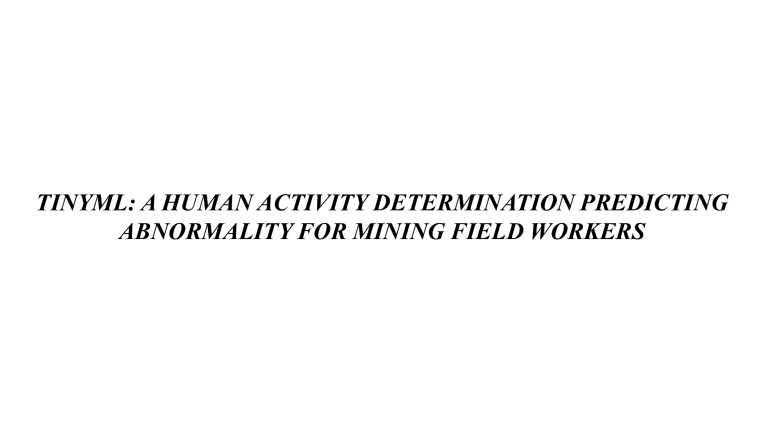
TINYML: A HUMAN ACTIVITY DETERMINATION PREDICTING ABNORMALITY FOR MINING FIELD WORKERS CONTENTS • Problem Statement • Objective • Literature Review • Introduction/Abstract • Existing System • Disadvantages of Existing System • Proposed System • Advantages of Proposed System • Architecture • Hardware Requirements • Software Requirements • Applications • References PROBLEM STATEMENT • No protection system designed for field workers condition monitoring • Loss of life due to unpredicted condition of workers • Costlier activity prediction system OBJECTIVE • To effectively develop a TinyML concept for the field workers. • To implement an early alerting system to save the life of the workers. • To implement long distance data transmission in areas with no internet connectivity. 4 ABSTRACT/INTRODUCTION • In many countries more than half of workers are employed in the informal sector with no social protection for seeking health care and lack of regulatory enforcement of occupational health and safety standards. • Employment and working conditions have powerful effects on health equity. • The health of workers is an essential prerequisite for household income, productivity and economic development. • Health risks at the workplace, such as workers working in high zones experience oxidation problems, body heat problems, risk of falling down and so on. • Conditions of employment, occupation and the position in the workplace hierarchy also affect health. • These conditions needs to be monitored then and there to avoid risking the worker life. • In this project we provide a solution where the condition of the worker in terms of oxidation, heart rate, temperature and position is monitored and given to a machine learning model deployed in a chip to predict the worker condition. • An independent mobile app is developed to provide notifications about abnormalities. • Thus this project provides efficient worker monitoring system saving their life. 5 EXISTING SYSTEM • The existing system proposes a proof-of-concept device to continuously assess the usage of handheld power tools and detect construction working tasks (e.g., different drilling works) along with potential misusages, e.g., drops, with an energy efficient architecture design. • The designed device is based on Bluetooth low energy (BLE) and NFC connectivity. BLE is used to exchange data with a gateway, whereas NFC has been chosen as an energyefficient wake-up mechanism. • A Tiny Machine Learning (TinyML) algorithm is proposed to process the data directly on board and achieve low latency and high energy efficiency. • Achieved an accuracy of 90.6% with a model size of roughly 30 kB. 6 DISADVANTAGES OF EXISTING SYSTEM • The concept is based on the handheld tool functioning and not focuses the worker condition. • The BLE, NFC used has a limitation of distance for transmission leading to issues when data is not transmitted successfully 7 LITERATURE REVIEW TITLE OF THE PAPER AUTHOR NAME ALGORITHM ADVANTAGE DISADVANTAGE Design and Performance Evaluation of an UltralowPower Smart IoT Device With Embedded TinyML for Asset Activity Monitoring Marco Giordano, Tiny Machine Learning Nicolas Baumann, (TinyML) algorithm Raphael Fischer, and Michele Magno, Michele Crabolu and Giovanni Bellusci The proposed model takes As a battery replacement in these advantage of the convolutional circumstances is difficult and expensive. layers, achieving comparable accuracy with an extremely optimized model size, capable of running on resource-constrained devices. A.I. Neural Networks Inference into the IoT Embedded Devices using TinyML for Pattern Detection within a Security System Cristian TOMA EEPROM-machine Marius POPA learning algorithm. The device will be used for The AI field is not accessible by any actor performing various inferences in ICT industry. according with the learning output. 8 LITERATURE REVIEW TITLE OF THE PAPER AUTHOR NAME ALGORITHM ADVANTAGE DISADVANTAGE Toward More Detailed Field Betson and Marius Machine learning Monitoring of Variable Source [1969], Weyman Areas: [1970, 1973], Jones [1971], and Dunne and Black [1970a, b] Conditions of through flow generation the It has not until recently been explicitly construction and use of such a 'flow net' are examined in source areas. justified. Field Worker Exposure to Selected Insecticides Applied to Com Via Center-Pivot Irrigation: Insecticide exposures assessed with gauze- The margins of safety (MOS) values pad methodology helped indicate the increased as the exposure interval potential risk for field workers. increased. MOS =1.0 indicates that the exposure may cause some health effects, including acetylcholinesterase enzyme inhibition. Shripat T. Kamble, PTDPH Matthew E. Byers,l JOHN F. Witkowski, Clyde L. Ogg, And Gerald W. Echtenkamp LITERATURE REVIEW TITLE OF THE PAPER AUTHOR NAME Methods for Assessing Fieldworker Hand Exposure to Pesticides during Peach Harvesting: Durham and Wolfe Deep learning 1962; Davis 1980; Noel et al. 1983; Zweig et al. 1983 An Integrated Microsystem for P. Malcovati 3-D Magnetic Field F. Maloberti Measurements ALGORITHM Magneto dosimete ADVANTAGE DISADVANTAGE The major limitations of current hand The relative absorption of pesticides by exposure assessment methods for human skin and cotton gloves could field harvesters. validate the use of glove monitors. The schematic of the used high- When the chip is not selected (CS), the input-impedance instrumentation whole system enters in power-down mode amplifier. (the analog blocks, including the sensor are switched off) PROPOSED SYSTEM •Our system continuously monitors the patient’s vital signs and sense abnormalities. The monitored data is delivered to medical Upon encountering abnormalities, the system alerts the medical about the abnormal parameter. •Thus, reduces the need for manual monitoring done by the medical. •Our proposed system uses MQTT clients to send data from sensors to the cloud platform. It is a publish/subscribe, extremely simple and lightweight messaging protocol, designed for constrained devices and low-bandwidth, high-latency or unreliable networks. •The design principles are to minimize network bandwidth and device resource requirements whilst also attempting to ensure reliability and some degree of assurance of delivery 11 ADVANTAGES OF PROPOSED SYSTEM • Safeguards the field workers life • Enables long distance communication using LoRa • Overcomes the disadvantages of existing system effectively 12 ARCHITECTURE DIAGRAM 13 HARDWARE REQUIREMENTS • Power supply • ESP8266 • DHT11 sensor • SPO2 sensor • Accelerometer sensor • Power supply unit • Base board 15 SOFTWARE REQUIREMENTS • Arduino 16 APPLICATIONS • Used for wireless and long data transmission • Field worker monitoring • Mining worker monitoring 17 WORK PLAN Review Work Status 0th •Identifying area of work and problem statement •Solution provided •Various study regarding project 1st •20-30% of project completion - 2nd •50-60% of project completion - 3rd •Entire project completion - Completed 18 TIMELINE WORK PLAN 100 100 PERCENTAGE OF COMPLETION 90 80 70 60 60 50 40 40 30 20 20 10 0 Review 0 Review 1 Review 2 Review 3 NUMBER OF REVIEWS 19 REFERENCE [1] Marco Giordano, Nicolas Baumann, Raphael Fischer, and Michele Magno, Michele Crabolu and Giovanni Bellusci, “Design and Performance Evaluation of an Ultralow-Power Smart IoT Device With Embedded TinyML for Asset Activity Monitoring”, 2022 [2] Cristian TOMA Marius POPA, “A.I. Neural Networks Inference into the IoT Embedded Devices using TinyML for Pattern Detection within a Security System”, 2020 [3] Betson and Marius [1969], Weyman [1970, 1973], Jones [1971], and Dunne and Black [1970a, b], “Toward More Detailed Field Monitoring of Variable Source Areas”, 2019 [4] Shripat T. Kamble, Matthew E. Byers,l JOHN F. Witkowski, Clyde L. Ogg, And Gerald W. Echtenkamp, “Field Worker Exposure to Selected Insecticides Applied to Com Via Center-Pivot Irrigation” [5] Durham and Wolfe 1962; Davis 1980; Noel et al. 1983; Zweig et al. 1983, “Methods for Assessing Fieldworker Hand Exposure to Pesticides during Peach Harvesting” [6] P. Malcovati, F. Maloberti, “An Integrated Microsystem for 3-D Magnetic Field Measurements” 22

